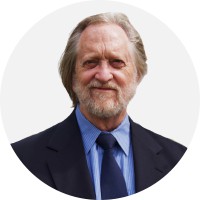The views expressed in our content reflect individual perspectives and do not represent the authoritative views of the Baha'i Faith.
During my half-century as a university professor and publishing scholar, I devoted a good deal of time to an obvious but puzzling question: If we presume an omnipotent Creator exists, why did He decide to give a physical dimension to His creation?
Or, stated in more personal terms, if the creation of human beings lies at the heart of the purpose of physical reality—as most religions suppose—then why did the Creator decide that we would benefit from waking up in an environment where we think we are physical beings, when we really aren’t; where we think we own stuff, when we actually don’t; and where we seem to constantly worry about dying, when our conscious self together with all our essential human powers will endure forever as properties of our eternal soul?
My first attempt to get to the heart of this question, a book entitled The Metaphorical Nature of Physical Reality, discussed the premise that physical reality is a poetic or metaphorical expression of abstract virtues and, as such, provides a foundational methodology for human beings to become introduced to a higher, nobler, and more permanent spiritual reality.
In this work, I applied the terms and techniques of literary studies, which describe how metaphor works, to demonstrate that analogical processes provide a useful means for the human mind to be introduced to, acquire, and understand ephemeral or metaphysical realities—making it possible for us to approach the entire physical part of our lives as a dramatic teaching device.
RELATED: The Physical World: One Great Parable of Life
My next book-length study of this subject, The Purpose of Physical Reality: The Kingdom of Names, dealt with the way in which physical reality and our experience in it might correctly be described as a classroom where we prepare for the continuation of personal development after the dissociation of our selves—our soul with all its complement of powers and faculties—from our physical body.
This work concludes by observing that one of the really useful devices this classroom offers us as preparation for that transition—we might think of it as a workshop or “breakout” session—is aging, an ingeniously devised experience in which we gradually watch our skin become wrinkled, feel our joints falter, our organs failing, and the whole organic physical construct become incrementally more dysfunctional until it dies, decomposes, and, according to Walt Whitman, becomes “leaves of grass,” or, in my own case, a bit of crab grass.
The next stage in my study of physical reality as an expression of a coherent and logically structured expression of a divine plan for human education was The Arc of Ascent: The Purpose of Physical Reality II. The central thesis of this book—that individual spiritual development in the context of the physical classroom is inextricably linked to our reality as inherently social beings—led me to the conclusion that all individual virtue is largely theoretical until practiced and developed in the context of human relationships.
For example, a hermit dwelling in a mountain cave may consider himself to be extremely mystical and spiritual, completely kind and selfless, but neither he nor we can be sure he has acquired such virtues unless and until he emerges from his seclusion to help somebody, not once, but enough times that his theoretical virtues become habituated and thus integral attributes of his character.
The thesis of the series of essays you’re reading now came from ideas developed in my third assault on this endlessly fascinating question, entitled Close Connections: The Bridge between Spiritual and Physical Reality. As the title implies, this lengthy and complex discourse analyzes how the gap between the metaphysical and physical aspects of reality is bridged constantly and bi-directionally on both the cosmic and the individual level. Stated axiomatically, this work compares the theory that an essentially unknowable metaphysical being—the Creator—runs physical reality, with the parallel theory that an essentially knowable metaphysical being—the human soul—operates the human body.
RELATED: Why Do Spiritual Beings Need a Physical World?
As Abdu’l-Baha so clearly pointed out in a talk he gave in Paris, God employs His messengers as intermediaries between Himself and physical reality, even as we employ our brains as intermediaries between our “essential self” and our bodies:
Like the animal, man possesses the faculties of the senses, is subject to heat, cold, hunger, thirst, etc.; unlike the animal, man has a rational soul, the human intelligence, whereby he can think abstractly, or meditate and reflect on philosophical or theological questions.
This intelligence of man is the intermediary between his body and his spirit.
When man allows the spirit, through his soul, to enlighten his understanding, then does he contain all Creation; because man, being the culmination of all that went before and thus superior to all previous evolutions, contains all the lower world within himself. Illumined by the spirit through the instrumentality of the soul, man’s radiant intelligence makes him the crowning-point of Creation.
If this thesis is correct, even as you at this moment read this essay, you and I are conversing soul-to-soul by means of a series of intermediaries.

The written expression of ideas emanated from my conscious mind through the intermediary of my brain. It was then published here at BahaiTeachings.org, and is at this moment being translated by your senses into abstract concepts through the capacity of your brain, which then transforms the complex of symbols that constitute human language into meaning.
Your conscious mind then considers these ideas, and either rejects them as unworthy of being retained or stores them in the repository of your memory and the convictions of your inner being.
So, to put it in terms that contemporary physics might find appealing: how can we defend the thesis that essentially metaphysical beings—and therefore, for the majority of contemporary scientists, nonexistent beings—think themselves capable of operating heavy machinery without hurting anyone?
In Close Connections I discuss critical questions related to evolution, particle physics, astrophysics, history, cosmology, anthropology, medicine, physiology, psychiatry, and all sorts of other fields directly affected by the assertions that metaphysical reality exists and, more important, that there is a strategic and systematic interplay between the metaphysical and physical aspects of reality. Most important in this study is the consideration that these relationships are at the heart of any understanding about how reality works at every level of existence.
My overall objective in Close Connections is to demonstrate an integrative view of reality provided in and corroborated by authoritative Baha’i texts. But since I cannot in a single series of essays discuss all the support for a thesis wrought over ten years, several books, and hundreds of pages of research, I have decided to focus here on one of the fundamental themes in that study: the relationship between the religious axiom that the human purpose is to love God, and the decision of the Creator to make the method by which we can attain this love relationship subtle, indirect, initially physical, poetic, and, consequently, largely hidden and concealed from intuitive knowledge.
In other words, how do we love God when we cannot possibly know the essential reality of God?
This represents a supremely difficult challenge—unless, of course, we are first led out of the cave of ignorance by mentors, and set on the path of willed, self-sustained progress, a process that translates well the Latin verb educare (to lead out) into the English cognate “to educate.”
Coupled with this idea is another equally enigmatic concept: love. Since, according to the Baha’i teachings, the human purpose is to learn to know and to worship God, or to love and to express that love in action, then it is crucial that we understand how both processes work, as neither learning nor loving can be coerced, even by God, because both require us to employ our free will, and our will cannot be free if it is coerced.
So please follow along in this series of essays as we explore what the Baha’i teachings recommend when they ask us to kindle the fire of divine love in our hearts and souls.
This series of essays is adapted from John Hatcher’s address to the 2005 Association for Baha’i Studies Conference titled The Huri of Love, which comprised the 23rd Hasan M. Balyuzi Memorial Lecture.
















Comments
Sign in or create an account
Continue with Googleor